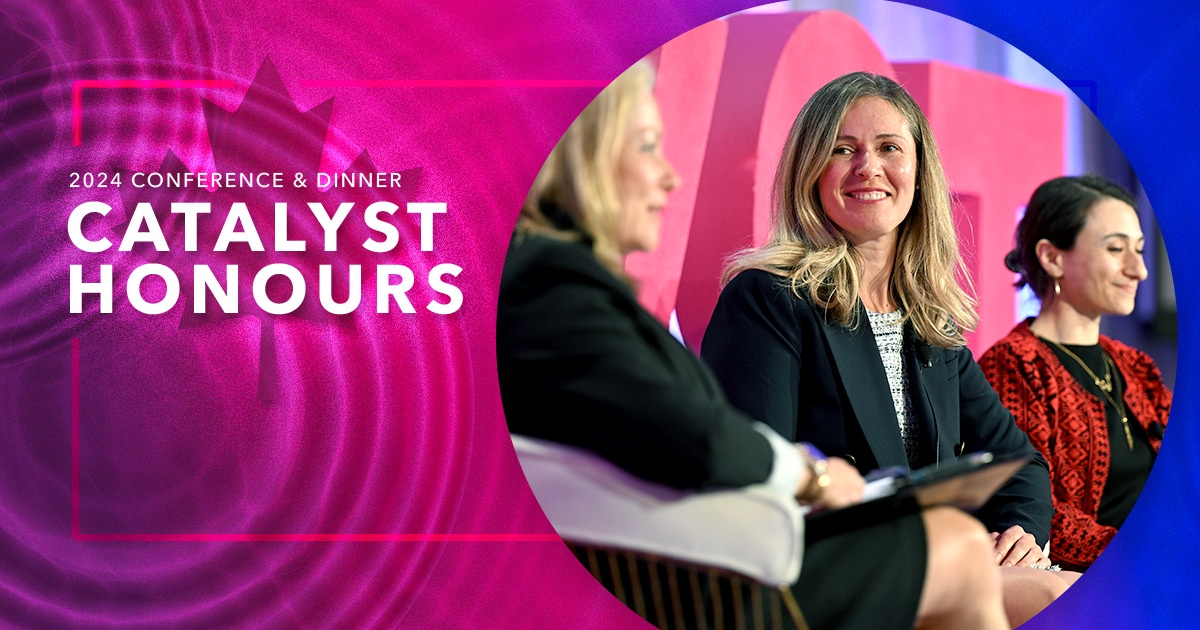How to break barriers for women in STEM, tech, and trades

Executive Summary
To achieve true competitive innovation, STEM workplaces must drive industry-wide culture change.
Women make up less than 30% of Canada’s STEM workforce, according to Statistics Canada, but luckily that balance is shifting as more women gain STEM post-secondary qualifications.
To achieve true competitive innovation, STEM workplaces must drive industry-wide culture change. Catalyst gathered women leaders representing the engineering, tech, and trades sectors to discuss their workplace experiences in the 2024 Catalyst Honours conference session “Rising Innovators: Women Leading the Charge in STEM, Tech, and Trades.”
Representation and role models matter
Delaney Krieger, RSE Interior Systems Mechanic & Career Support Specialist, Build a Dream, turned to construction when she realized how expensive college would be, coupled with how unmotivated she was to continue with schooling after high school.
But her first full-time trade job got off to a rough start. She said, “When I started, I was actually the first woman hired by my company to work [with] the tools. I remember showing up to a job site with all of my PPE (personal protective equipment), which didn’t fit me properly. I was kind of walking around playing dress-up in my father’s clothes, it felt like… boxy t-shirts and… very uncomfortable. I automatically didn’t feel like I belonged there.
“And the guys I was working with, they’d never worked with a woman before and that baffled me. They’ve been in the industry for 40, 45 years, some of them, and they’ve never worked with a woman. They didn’t know how to navigate that. […] There were a lot of barriers that if I would have just had a female role model that I could look up to, I definitely would have struggled a lot less,” Krieger said.
To shift gender representation in trades, organizations must use intersectional, equitable hiring practices that reduce bias; create sponsorship and mentorship programs, and look for ways to de-bias the systems. Kreiger now works with Build a Dream, an organization that helps connect young women with careers in skilled trades and other roles where women are traditionally underrepresented.
Psychological safety is a key to success
Born and raised in Ukraine and later emigrating to Canada, Valariya Yesypenko, VP, Global Data Governance, Manulife, spoke about her experience in tech: “You sit there and think, ‘Okay, I’ve been graciously invited to be a part of this boys’ club. How do I not say the wrong thing? How do I appear to be like them? How do I appear understood?’ And on top of that I have [an] accent, I make mistakes in my grammar. What does that result in? I just sit there and smile politely and feel like I’m absolutely useless. That productivity, that creativity and innovation is stifled.
“Now, imagine yourself on a team that has representations from all cultural backgrounds, from different genders, from LGBTQ, from visible minorities…. Everybody’s different and nobody’s different. Psychological safety is achieved. Everybody can speak up and share ideas…the companies thrive, productivity is achieved. It’s a brilliant and beautiful scenario that I think everybody should embrace and support.”
Organizations that invest in creating psychologically safe spaces and commit to supporting their employees through their actions and values can boost employee satisfaction and retention.
Inclusive leaders drive culture change
Lina Qamar, an engineer who began her career with only one other woman in her department, now helps develop talent at Linamar. Over time, she has seen a steady increase of women in engineering.
Qamar credited the camaraderie of other women with keeping her in engineering. She also emphasized the tone from the top at her organization. “Our leadership were all definitely our allies,” Qamar said. “There was very low tolerance towards… I will say ‘nonsense’ to summarize it. Low tolerance towards sexist behavior, low tolerance towards bullying, low tolerance towards all of that. And I think that’s so important from leadership: not necessarily immediately dismissing someone who acts in a sexist way or says perhaps a racist remark, but a focus on educating, a focus on saying, ‘This is not us. This is not our culture. Going forward, we behave in this way.’ “
She continued, “Not once did I feel that my personhood, my existence as who I am, was an issue. My contribution was what mattered. My work as a team player was what mattered…Lina being she/her was not a factor. So, I think that was huge.”
Qamar’s experience is backed up by research. Catalyst found that employees in women-led frontline teams are less likely to experience hostile, sexist behavior.
Empower your frontline teams to challenge gender stereotypes with MARC for the Front Line training.